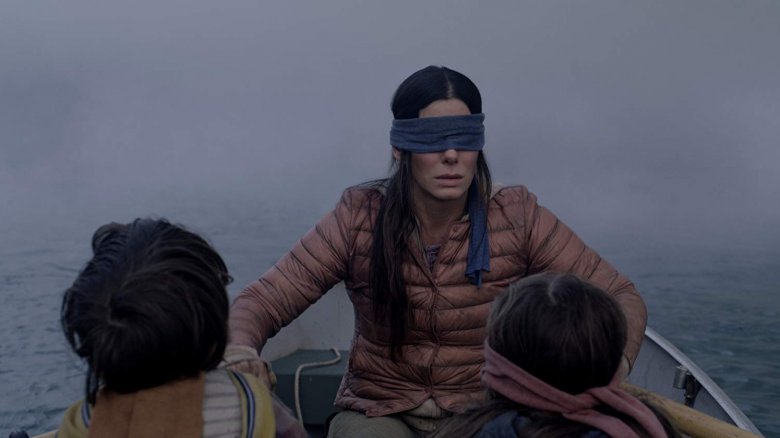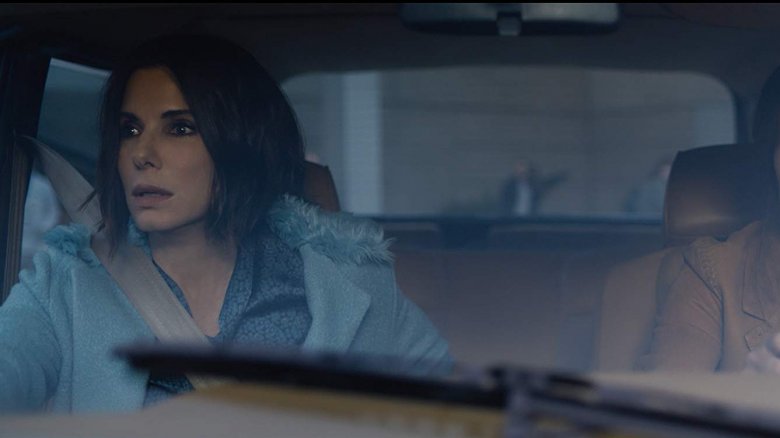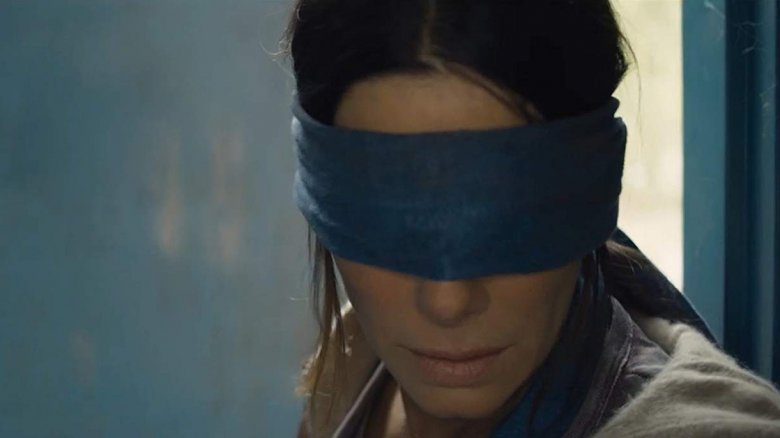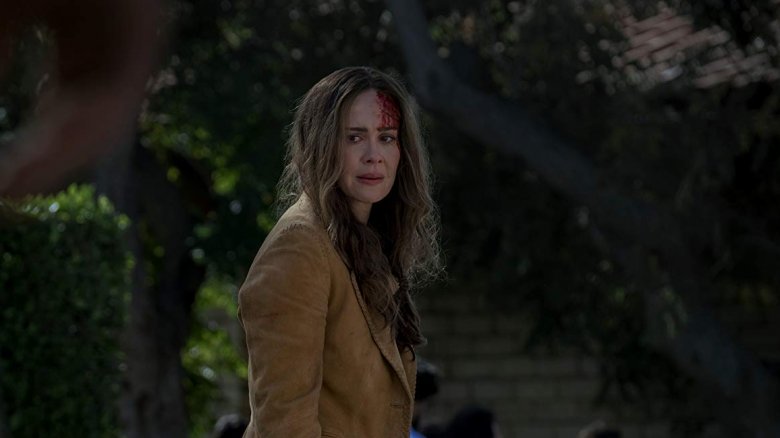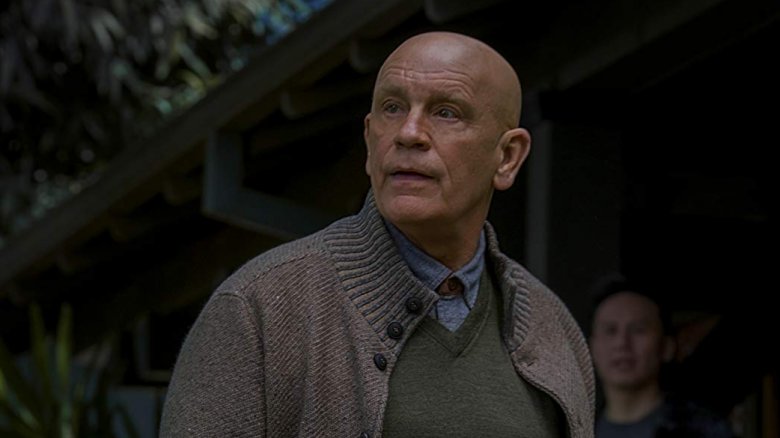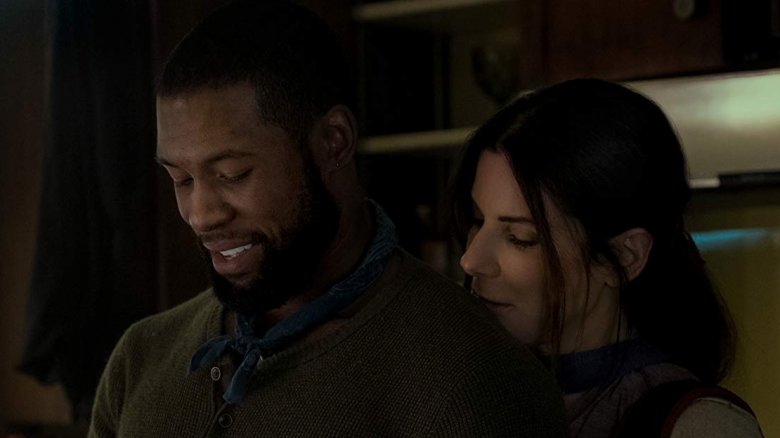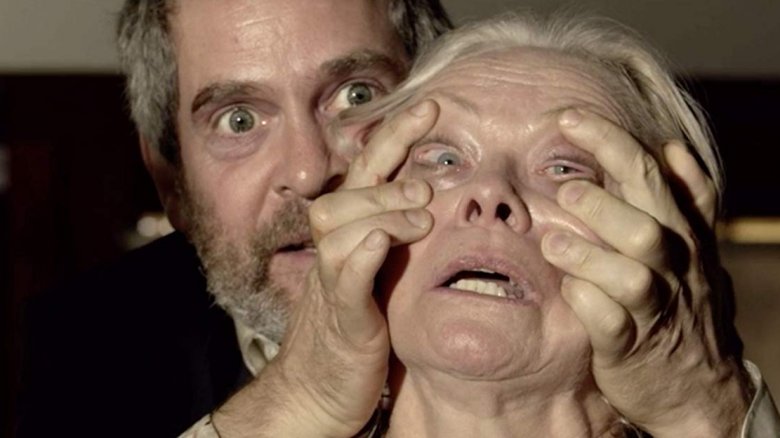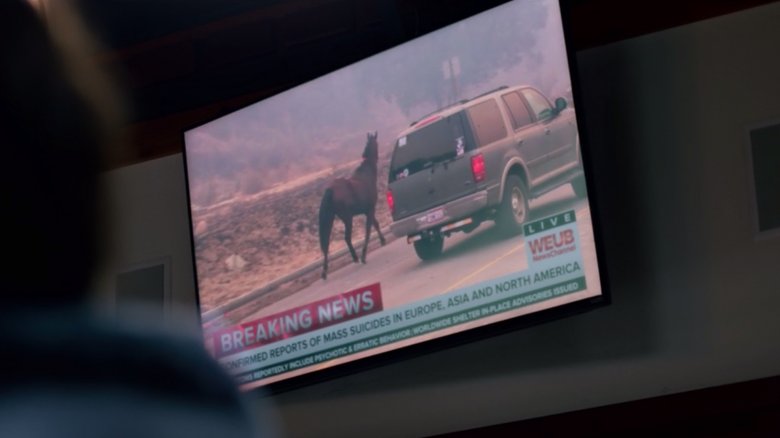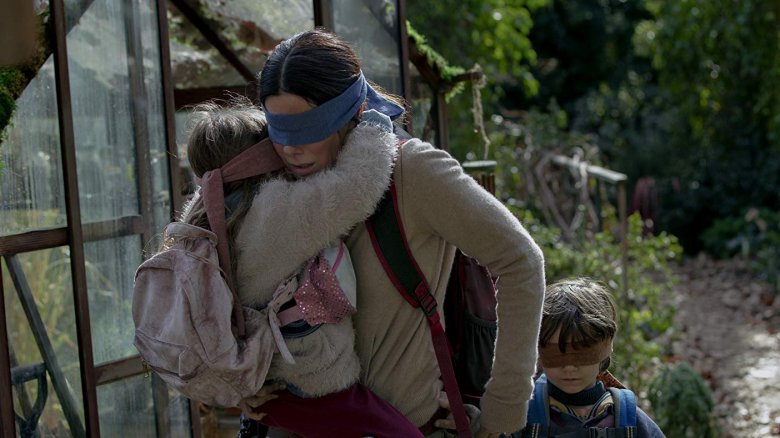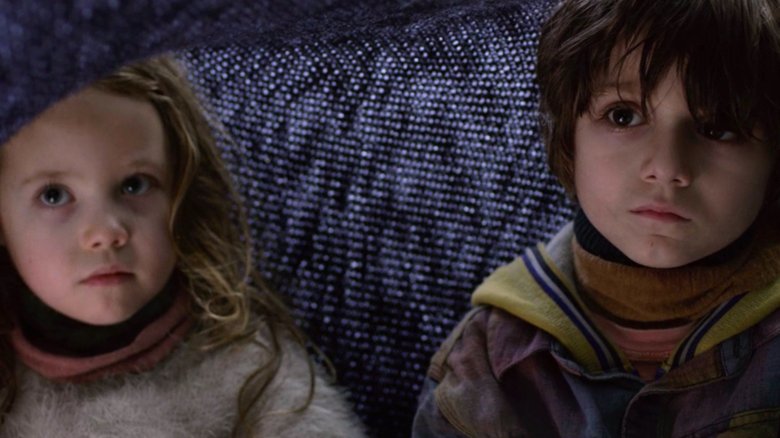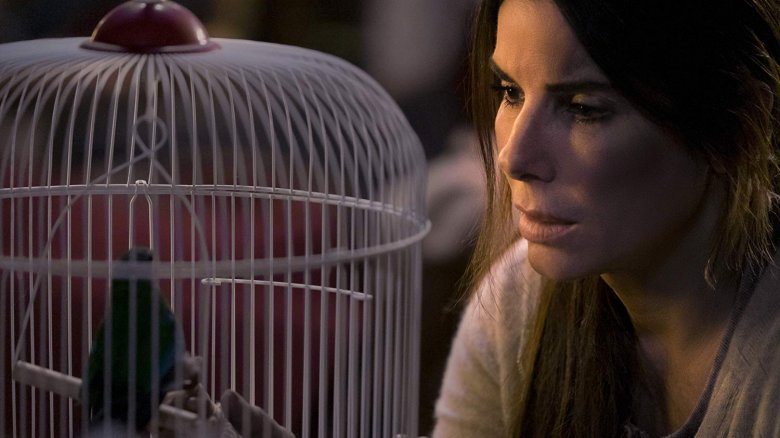How Netflix's Bird Box Was Different From The Book
From the moment Netflix's Bird Box arrived on the streaming platform, the movie garnered tons of attention. That's no exaggeration: Netflix estimated that the film was watched by roughly 80 million Netflix subscribers in the four weeks after its launch.
The movie, based on John Malerman's novel of the same name, shares the same premise as the book: society starts falling to pieces as monsters drive those who see them to commit suicide. While the movie doesn't stray too far from the book, director Susanne Bier certainly exercised a few creative freedoms by omitting and even adding information, characters, and events that don't exist in the source material.
Some differences change the overall story more substantially than others, but all of them come together to make the movie uniquely different from its book counterpart. Here's a look at just a few of the differences that readers will be able to catch when watching Bird Box.
Time passes differently
While the spread of monsters happens over a span of months in the book, the movie immediately delves into a post-apocalyptic scenario as society falls victim to the swarm of suicides caused by the invaders. In a stroke of good luck, Malorie, played by Sandra Bullock, finds shelter with a group of survivors, and the group bands together to survive the chaos.
In the book, Malorie doesn't join the other survivors until three months after the first wave of suicides begins in the United States. She and her sister take shelter together and plan to wait out the situation in safety. Not everyone immediately succumbs to the monsters, so the book's pace is much slower. It's only after Malorie's sister dies that she seeks out the group of survivors. And unlike the movie, in which the group spends only a couple of weeks together, Malorie sticks with them for roughly half a year.
Malorie's character is more independent
In the movie, Malorie becomes a leader immediately. After she takes a minute to steady herself upon entering Greg's house, Malorie grabs the shotgun and takes charge when Tom decides to open the front door to let Olympia in. When Charlie is reluctant to go to the supermarket, Malorie calms him down and convinces him to go along with the group. Though she isn't the leader of the survivors like Tom, she rises to the occasion to make decisive change.
Malorie is more emotionally vulnerable in the book. Her internal monologue shows many more instances of self-doubt than are betrayed by Bullock's performance. At the beginning of the crisis that befalls the planet, Malorie is less take-charge and more likely to get approval from other people. Before Gary kills the survivors in the house, Malorie often looks to Tom in particular for guidance, and she starts off as more of an average character who has to learn as the situation progresses.
Malorie's sister dies much quicker
For the Netflix adaptation of Bird Box, Malorie's sister's name switches from Shannon to Jessica. However, her name isn't the biggest change the filmmakers made when adapting her character. Jessica, played by Sarah Paulson, dies relatively quickly in the film, intentionally crashing her car with Malorie in the passenger seat. After that fails to fatally injure her, Jessica steps directly into the path of an oncoming garbage truck, ensuring instant death as she's hit at full speed.
In both versions Malorie's sister dies, but how and when differs. In the book, Shannon convinces Malorie to board up the house for safety. The sisters end up living together for three months, watching the news and listening to the radio for updates on the outside world. One day while Malorie is watching television, she hears a thud from upstairs. After going to investigate and not hearing her sister answer when Malorie calls for her, Malorie finds that one of the blankets that was covering a window had a corner coming loose, letting in light from the outside. Worrying about her unresponsive sister, Malorie looks in the bathroom to find her sister bleeding out on the floor with a pair of scissors protruding from her still chest.
The survivor group has different members
Bird Box features a colorful cast of survivors, but not all of the characters made the cut for the Netflix movie. The characters Jules and Don do not make an appearance; however, Don is highly reminiscent of a character created specifically for the movie. Douglas, played by John Malkovich, shares a few of Don's traits, most notably his bluntness and cynicism. Both characters firmly assert that they're concerned about the amount of food stockpiled in the house and are against taking in any new mouths to feed.
Douglas isn't the only character created solely for the movie. The film adds three other characters: Charlie, a supermarket employee writing a book about how the end of the world is depicted in different cultures; Greg, the owner of the house everyone takes refuge in; and Lucy, a young woman who later steals the group's only car and runs away with Felix, another survivor.
Tom has a much larger role
In the film, Tom kills Gary before he can force Malorie or the two babies to open their eyes and ultimately commit suicide. After this, he lives with Malorie for five years helping to protect and raise the two children. During this time, he acts as a father to the children and as a husband to Malorie. Tom meets his demise in the film while protecting Malorie and the children from people trying to force them to look at the monsters.
In the book, Tom's role is much more minimal: He dies when Gary goes through the house and forces everyone to look at the monsters. As Malorie and Olympia give birth upstairs, Tom and all the other survivors are killed in the frenzy. Additionally, Tom is never romantically involved with Malorie in the book. Though there are several passages describing his blue eyes and sandy blond hair, there's never anything more than unexplored romantic chemistry between Malorie and Tom.
Monsters are more malicious
The main threat in both the book and the movie are the monsters, but the movie adds tension by making the monsters more malicious. In many instances, the monsters and their human agents can be seen specifically targeting people and actively trying to remove people's blindfolds, the only thing keeping them from death.
The book is a bit more ambiguous regarding the monsters. One notable example is when Malorie makes the journey with the two children and runs into a monster on the river. The monster does attempt to take off her blindfold, but backs off when Malorie protests. While not explicitly stated, it can be implied in the book that the monsters aren't necessarily evil.
Instead, they're more reminiscent of creatures from Lovecraftian horror that remain outside the realm of human comprehension. This is in direct contrast to the movie, where the beings are comparable to demons that go out of their way to hurt people. One example is when Girl is lured by the monsters and almost convinced to remove her blindfold — the monsters mimic Malorie's voice in an attempt to trick Girl into her own demise.
Animals aren't affected by monsters
Outside of the birds kept by the survivors and Jessica talking about how horses make good mothers, animals aren't a primary focus of the movie. Additionally, the birds aren't affected by the monsters, so they can act as an alarm to warn Malorie when the monsters approach without being killed themselves.
Animals appear more often in the book — and aren't immune from the monsters. Malorie keeps Victor, a border collie, as a seeing-eye dog. Victor is exposed to one of the monsters and in a panic, chews off his own legs and dies.
Victor isn't the only animal killed by monsters in the book. While Malorie is on the journey, an entire flock of birds fall victim to the monsters, resulting in a bloody war above the boat. This makes the journey far more difficult for Malorie and the children as the bodies of birds pelt down on the trio, showering them with blood.
Boy and Girl receive less training
In the Netflix adaptation, Malorie learns of a potential safe haven from a mysterious voice on the radio. Tom is more optimistic about the new information, but Malorie is skeptical. She and Tom have managed to take care of the children and survive, so they decide to stay put. It's only after Tom's death that Malorie is pushed into making the journey.
In the book, Malorie knew about the river journey and the sanctuary for years, and knowing she couldn't make the journey with two babies, prepared her children accordingly. The children were vigorously trained from a very young age to never open their eyes. This is done in conjunction with other sound identification exercises, drastically enhancing the children's aural capabilities. The training ultimately pays off as the children begin hearing better than Malorie can.
While we see small glimpses of Malorie training the children in the movie, the severity is not at all comparable to the book. In the movie the children are allowed to use their eyes and simply cover them when going outside; this isn't the case in the book, where Malorie would punish the children for opening their eyes by hitting them with flyswatters.
Malorie almost sacrifices one of the children
One of the most intense points in the movie comes when Malorie takes Boy and Girl on the dangerous journey down the river. In an effort to reach a supposed sanctuary, Malorie must navigate dangerous river rapids completely blindfolded with two vulnerable children in tow. Knowing that the children won't make it if she's killed, Malorie informs the children that if they want to survive, one of them will have to take off their blindfold and look so Malorie can safely navigate the treacherous waters. Before her change of heart, the movie heavily implies that Malorie was going to choose Girl to do the task, which would almost certainly have led to the child's death.
While this is one of the most suspenseful points of the film, this moral dilemma is completely avoided in the book. Malorie asserts that she will be the one to take off the blindfold from the start of the journey, not the children.
Birds play a different role
While birds are used as an alarm to signify a monster is nearby in both the book and the movie, the movie gives birds a very different role. In the book, the birds also start making noise if anyone comes near their cage. Tom decides the birds would make for a good makeshift alarm system, so he puts their cage outside the front door of the safehouse. This is essentially where their utility ends.
One of the biggest differences between the book and the movie is that in the book, birds are just as susceptible to the monsters. The birds in Malorie's care are affected by the monsters and kill themselves before Malorie goes on the journey. In the movie, the birds can't be affected, and Malorie takes them with her on the river.
The movie frames the birds as less important for the characters' survival; instead, they're a symbol of hope. When Malorie and the children reach the sanctuary and are finally out of harm's way, the birds are released, signifying their newfound freedom and safety.
